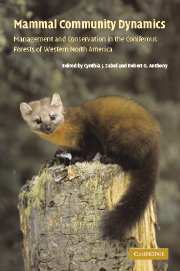 Mammal Community Dynamics
Mammal Community Dynamics Published online by Cambridge University Press: 15 December 2009
Introduction
Large carnivores operate over large spatial scales and affect and are affected by multiple ecosystem processes (e.g., predation, migration, climate, fire, etc.). Thus carnivore ecologists must deal with expansive areas and multiple scales and disciplines. For this reason, studies of top carnivores have played a significant role in fostering ecosystem approaches among managers and researchers (Minta et al. 1999). Specifically, wolves (Canis lupus), cougars (Felis concolor), and bears (Ursus spp.) have become important symbols for conservation and ecosystem management. Recent research has examined multiple large carnivores (Kunkel et al. 1999, Carroll et al. 2001) and multiple ecosystems in regional conservation networks (Soule and Terborgh 1999). Conservation perspectives resulting from such work can help build strategies to protect appreciable amounts of native biological diversity (Noss and Cooperrider 1994, Paquet and Hackman 1995, Soule and Terborgh 1999). Conservation strategies that focus on charismatic animals such as large carnivores have additional advantages because such a focus motivates organizations and the general public.
Even though large carnivores often are grouped for management and share many traits, some important differences affect their resiliency (Weaver et al. 1996). The most obvious split occurs between the obligatory predators (cougars, wolves, and jaguars (Panthera onca)) and the omnivorous facultative predators (bears). Cougars, wolves, and jaguars have higher dispersal capabilities and higher reproductive rates than bears. Wolves are social; cougars, jaguars, and bears are solitary.
To save this book to your Kindle, first ensure [email protected] is added to your Approved Personal Document E-mail List under your Personal Document Settings on the Manage Your Content and Devices page of your Amazon account. Then enter the ‘name’ part of your Kindle email address below. Find out more about saving to your Kindle.
Note you can select to save to either the @free.kindle.com or @kindle.com variations. ‘@free.kindle.com’ emails are free but can only be saved to your device when it is connected to wi-fi. ‘@kindle.com’ emails can be delivered even when you are not connected to wi-fi, but note that service fees apply.
Find out more about the Kindle Personal Document Service.
To save content items to your account, please confirm that you agree to abide by our usage policies. If this is the first time you use this feature, you will be asked to authorise Cambridge Core to connect with your account. Find out more about saving content to Dropbox.
To save content items to your account, please confirm that you agree to abide by our usage policies. If this is the first time you use this feature, you will be asked to authorise Cambridge Core to connect with your account. Find out more about saving content to Google Drive.